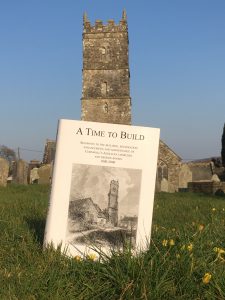A time to Build: first book to overview Cornwall’s churches launched
The first comprehensive overview of Cornwall’s Anglican church buildings covering the 19th and 20th centuries has finally hit bookshelves.
 A Time To Build – Signposts to the Building, Restoration, Enhancement and Maintenance of Cornwall’s Anglican Churches and Mission Rooms 1800-2000 has been written by Canon Michael Warner, former Truro Diocesan Advisory Committee secretary.
A Time To Build – Signposts to the Building, Restoration, Enhancement and Maintenance of Cornwall’s Anglican Churches and Mission Rooms 1800-2000 has been written by Canon Michael Warner, former Truro Diocesan Advisory Committee secretary.
The book, which retails at £45, has been described as ‘the consequence of a lifetime’s study and research’. Indeed, Canon Michael has been an ordained priest for 50 years and has served in the Diocese of Truro for 45 of those years.
Historian Dr Jo Mattingly has reviewed the book. She says: “Equally a guide for Cornish church afficianados and local historians as for priests, churchwardens and Diocesan Advisors, A Time to Build can be highly recommended. It will, I am sure become, one of the key reference works of the 21st century and not just in Cornwall.”
Dr Jo Mattingly’s review is included below.
A Time To Build by Michael Warner is available by writing to 98 Porthpean Road, St Austell, Cornwall, PL25 4PN; by calling 01726 64130, or emailing m.j.w.w@btinternet.com
A Time to Build – Signposts to the Building, Restoration, Enhancement, and Maintenance of Cornwall’s Anglican Churches and Mission Rooms 1800-2000 by Michael Warner (Scryfa, 2022), 342pp.
This epic and long-awaited work has been 35 years in the making. Begun when Michael Warner was secretary to the Truro Diocesan Advisory Committee, his fat black file was a regular, and very welcome, visitor to DAC meetings and more reliable than Pevsner. Essentially this book is a gazetteer of scrupulously researched and checked faculty and restoration information – two centuries of Anglican ‘sanctions and permissions’. It covers all Cornish Anglican churches from Advent to Zennor and includes the Victorian Mission churches – a very useful record which builds on the work of the late Alan Dunstan.
The introduction sets the scene nicely, with legal issues and the formation of DACs dealt with in chapter 2 and memorials and high-low church controversies elsewhere. Neglect is the theme of chapter 1, and Victorian restorations are covered in chapter 3.
At Botus Fleming an imminent roof collapse was feared in the 1830s, portions of floor were vanishing into the vaults at Pelynt and St Enodoc was a glorified sand pit. Generous vicars, like Reverend Thomas Fisher at Roche, restored their churches even if it meant stinting themselves, but normally funds had to be found from the community.
Thirty-six new churches were built by 1849-70 when Sir Stephen Glynne visited over half of Cornwall’s medieval churches at a time of major restorations. This coincided with the collapse of the Cornish mining industry. Emigration much reduced the local population and many restorations, especially J.P. St Aubyn’s, were pared back to the bone, sadly cramping his architectural flair.
A boost to both restoration and church building occurred in 1877 with the foundation of Truro diocese.
The early 20th century saw the completion of many projects begun more than half a century before. New church building – including Newquay’s church tower – and reordering resumed in the 1960s after a hiatus, with Giles Blomfield taking a lead. Today, church closure and finding alternative or complementary uses has become a major issue.
The gazeteer entries are clearly laid out in a chronological way. They are easy to skim through, with non-executed projects usually indicated. In searching for evidence of lost Cornish rood screens, I discovered, amongst other things, that Marhamchurch’s screen had been found in a wall of the parsonage in 1890 but then lost, Minster’s went around 1843 and by 1848 Tywardreath’s documented 1500s screen had been reduced to a a heap of lumber in the north transept.
Equally a guide for Cornish church afficianados and local historians as for priests, churchwardens and Diocesan Advisors, A Time to Build can be highly recommended. It will, I am sure become, one of the key reference works of the 21st century and not just in Cornwall.

